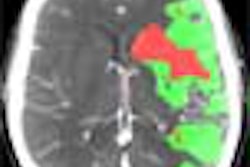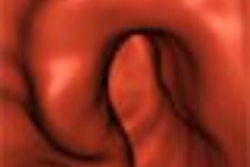Radiologists who perform virtual colonoscopy often cite its lack of perforation risk as a key advantage over endoscopy. VC is believed to offer other safety advantages as well, particularly in terms of cardiovascular risks. But no one had compared these effects empirically until researchers from London's St. Mark's Hospital decided to give it a go.
According to their results in 144 patients, virtual colonoscopy produces significantly fewer cardiovascular disturbances than either conventional colonoscopy or flexible sigmoidoscopy.
Several studies have focused on the psychological acceptability of virtual colonoscopy, however, little attention has been paid to its cardiovascular effects, wrote Dr. Stuart Taylor, Dr. Steve Halligan, and colleagues in the December issue of Radiology (Vol. 229, pp. 782-790).
"Conventional colonic endoscopy is associated with a small but well-recognized degree of morbidity and mortality, and, in contrast to CT colonography (VC), the cardiovascular effects of endoscopy have been thoroughly investigated," they wrote. "For example, hypoxia, hemodynamic disturbances, and cardiac arrythmias have all been well described, even when modern equipment and sedation techniques were used. While many of the adverse cardiovascular effects of endoscopy are related to the administration of sedative and analgesic medications, there is evidence that manipulation of the colon itself causes cardiovascular compromise. Those at particularly increased risk include the elderly, and patients with a history of cardiovascular disease."
Certain risks are inherent in virtual colonoscopy, too, with its obligatory bowel cleansing, rectal tube insertion, and colon insufflation, but these effects had not been quantified, according to the researchers from St. Mark's cardiology, radiology, and endoscopy departments. The study sought to compare the cardiovascular risks of virtual colonoscopy (144 patients) with those of conventional colonoscopy (104 patients) or flexible sigmoidoscopy (44 patients), with the entire cohort undergoing VC plus one form of endoscopy on the same day.
The patients (74 women mean age 63.9; 70 men, mean age 63.6) were referred for symptoms such as rectal bleeding (n=25), a change in bowel habits (n=38) or other factors that put them at increased risk of colorectal neoplasia. Following a 24-hour liquid diet and bowel preparation with two packets of sodium picosulphate or two packets of magnesium citrate, the patients underwent manual colon insufflation with CO2 to tolerance. Patients also randomly received 20 or 40 mg of intravenous hyoscine butylbromide (Buscopan, Boehringer Ingelheim, Bracknell, U.K.) as a spasmolytic agent.
Additional insufflation was performed if a scout image showed collapsed segments, then patients underwent prone CT scanning on a four-detector scanner (LightSpeed Plus, GE Medical Systems, Waukesha, WI). Parameters included 1.25 to 2.5-mm collimation, pitch 66, 120 kVp, 50-100 mAs, and 50 mAs. Another scout image was then acquired, and additional CO2 was introduced before supine scanning if needed to compensate for absorption of the gas.
Same-day colonoscopy (104 patients) was performed by a single experienced colonoscopist following administration of 10-40 mg Buscopan and an intravenously administered sedative (midazolam, Phoenix Pharma, Gloucester, U.K.), and an analgesic (pethidine, Pamergan P100, Martindale Pharmaceuticals, Romford, U.K.).
"Overall, 37 patients received 25 mg of pethidine and 1.25 mg of midazolam, 30 patients received 50 mg of pethidine and 1.25 mg of midazolam, 18 patients received 50 mg of pethidine and 2.5 mg of midazolam, and one patient each received 100 mg and 1.25 mg., 100 mg and 2.5 mg, and 100 mg and 4 mg of pethidine and midazolam, respectively," the authors wrote. "Nasal oxygen (2L/min) was routinely given to all patients undergoing colonoscopy."
Flexible sigmoidoscopy (40 patients) was completed without the use of spasmolytic agents, sedatives, or supplementary oxygen. Pulse, blood pressure, and oxygen saturation were recorded during CT and endoscopy at six time points throughout the procedure. In addition, a randomly selected subset of 40 patients (including 10 flexible sigmoidoscopy patients) underwent Holter ECG monitoring for the duration of the study. The patients' assessment of perceived pain was assessed during both the virtual and colonoscopic procedures. Paired t tests were used to statistically analyze oxygen saturation, pulse, and systolic and diastolic blood pressure during the procedures, and compared to baseline levels.
According to the results, the only significant effect of virtual colonoscopy when a spasmolytic was not used was a small increase in oxygen saturation, both during (P=0.03) and after (P=0.04) the procedure.
"Because we did not use supplementary oxygen, it seems likely that this is related to compensatory hyperventilation after breath holding during CT scan acquisition," the authors wrote.
When the spasmolytic Buscopan was administered, VC patients had a small but significant increase in oxygen saturation (P=0.04), and a postprocedural increase in pulse rate (mean increase, 19.9 beats per minute [P<0.001]) and a modest increase in diastolic blood pressure (5 mm Hg [P<0.001]).
Endoscopy's effects were more pronounced. Flexible sigmoidoscopy produced a significant decrease in diastolic blood pressure during (P=0.003) and after (P=0.005) the procedure, in addition to reduced oxygen saturation during the procedure (P=0.04), and significantly lower pulse rate after the procedure (P<0.001).
In patients who underwent sedation, all four measured variables changed significantly during colonoscopy, and all but pulse rate were significantly different after the procedure. The pulse rate increased (maximum mean, 17.8 beats per minute), while oxygen saturation fell by a mean of 1%. Systolic blood pressure decreased (maximum mean 16.6 mm Hg) along with diastolic (maximum mean 7.5 mm Hg.) (P<0.001), according to the authors. In 16 patients who did not undergo sedation, blood pressure did not change significantly, but pulse rate was significantly elevated both before and after the procedure (mean rise during colonoscopy, 18.4 beats per minute, P=0.002) and oxygen saturation decreased significantly (maximum mean, 1.4%, p=0.002).
"Compared with CT, oxygen saturation decreased significantly during and after colonoscopy and sigmoidoscopy (mean decrease after colonoscopy with sedation, 1.0%, P<0.001)," the authors wrote. "...Patients were 30.3 times more likely to develop bradycardia after endoscopy (95% CI: 2.65, 346, P=0.006). Ventricular couplets were significantly higher at endoscopy than at CT in patients with a history of cardiac disease (odds ratio: 72.5 and 95% CI: 4.56, 1,153 at CT versus odds ratio 14.6 and 95% CI: 0.96, 222 at endoscopy, P=0.002). Patients were 1.89 times more likely to register pain during colonoscopy than during CT (95% CI: 1.06, 3.38; P=0.03)." To indicate pain as it occurred, patients activated a handheld device during the exams.
A drop in blood pressure was significantly associated with colonoscopy performed with sedation compared to virtual colonoscopy, the authors wrote. "Furthermore, 18.3% of patients experienced systolic blood pressures less than 100 mm Hg and/or diastolic blood pressures less than 50 mm Hg -- levels that have previously been used to define clinically relevant hypotension -- during or after colonoscopy," they added. "The hypotensive effects of sedation are well described, and midazolam is known to depress myocardial contractability in addition to causing vasodilation, although it may reduce endoscopy-induced tachycardia." Colonic manipulation itself is associated with hypertension, bradycardia, and ECG disturbances, they noted.
And consistent with previous research, the risk of ECG changes was greater in patients with a history of cardiac disease, particularly ventricular tachycardia, which occurred in one colonoscopy patient during the study.
"Although there were no clinically overt manifestations of cardiac events in our cohort, it cannot be assumed that the cardiovascular disturbances we encountered are irrelevant," they stated. "In large population-based trials investigating the benefit of fecal occult blood testing for detection of colorectal neoplasia, the decrease in colorectal cancer mortality was countered by an increase in mortality from ischemic heart disease. The cause for this is unclear but could be related to colonoscopy, which is performed in patients with a positive fecal blood test result."
A previous study suggested that owing to increased cardiovascular risks, gastrointestinal endoscopy should be undertaken judiciously, weighing the risks and benefits in each patient.
Among the limitations cited, the authors cautioned that the data were weakened by their inability to randomize the order of the procedures. Because virtual colonoscopy always came first, they said, associated cardiovascular measurements were not "confounded" by previous exams, as was the case in the subsequent endovascular procedures.
"In summary, we found that CT colonography has no significant effect on cardiovascular parameters, other than a spasmolytic-induced tachycardia, whereas flexible sigmoidoscopy -- and colonoscopy in particular -- causes greater cardiovascular disturbance, which is largely related to the use of intravenous sedation...," the group concluded. "Patients found (virtual colonoscopy) less painful than colonoscopy and comparable to flexible sigmoidoscopy."
By Eric Barnes
AuntMinnie.com staff writer
December 31, 2003
Copyright © 2003 AuntMinnie.com




















